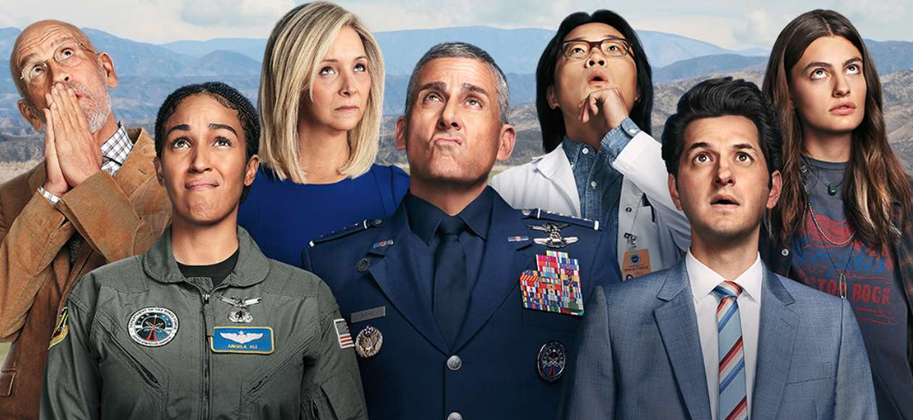Space Force: Why we’re watching the Netflix parody
The new Netflix parody series Space Force, starring Steve Carell, is currently #1 on the platform in Canada. We at Project Ploughshares are watching, too. On June 2, with our colleagues from the Centre for Peace Advancement, we hosted an online social event to watch the first episode. Inspired by U.S. President Trump’s call in 2018 to establish a Space Force as the 6th service branch of the U.S. military, Space Force charts a fictional path of the real organization that was – to the surprise of many – formally established last December.

During a pandemic and amidst protests against anti-Black racism, watching a parody of U.S. military bureaucracy may seem a frivolous activity for peace researchers. But the event did provide a way to focus on an element of our reality that we seldom see or think about: our dependence on outer space and the growing risk of conflict there.
Here are five insights from the show’s first season that deserve more thought from those of us in the peace community, and everyone else.
1. Why we need to fear conflict in space
Commander of the fictional Space Force, General Mark Naird (played by Carell) is mandated to put “boots on the Moon” so that the United States can “dominate space.” We see clear parallels with the “warfighting” focus of the real Space Force. Although human activity in outer space has been peaceful for decades, the show highlights the fact that international military competition in outer space is growing, increasing the chances of real, violent conflict.
Why does this matter? The show’s Secretary of Defense declares, “Our nation’s Internet, including Twitter, runs through our vulnerable space satellites.” In reality, our dependence on outer-space assets is even more complex and significant. However, this quote indicates why the security of outer space is critical not only for the military, but for all of us.
And, intentionally or not, the show raises valid questions about how to protect those vulnerable satellites.
2. The limitations of space weapons
If space is a “warfighting” domain, what kind of weapons might be used? Political leaders ask Naird if the new Epsilon “spacecraft fighter” being prepared for launch will have a “laser canon,” or a “pulse weapon,” but are told that these are fictional weapons from the Star Wars movies. Instead, Epsilon will carry a “kinetic disable system” in the form of a metal net, to “tangle with enemy satellites.” Also highlighted is a more exciting “Yellowjacket” prototype – a “satellite killer-killer,” which, unfortunately, explodes on the launch pad.
In the real world, militaries are challenged to protect satellites. They are even now grappling with what warfare in outer space means. Yet space is not a domain that can be easily dominated by weapons. The physics of this fragile environment are very different from anything on Earth. And the Outer Space Treaty – which receives a shout out in the final episode of the Space Force season – places legal and normative limits on the types of military activities that can be conducted there.
Space Force raises tough questions about what a real war in space could look like. We might use these questions to challenge the traditional thinking behind military security.
3. The cost of war
The cost and value of Space Force are constantly questioned in the show. The base where the force is stationed is seen as a waste of money. When the $6-billion Yellowjacket prototype explodes on the launch pad, its cost is relayed in social value: “four brand new middle schools.”
The show clearly illustrates the expense of war and warfighting in space. While it is a peculiar coincidence that the show launched in the midst of a global pandemic, its emphasis on the cost of war resonates in our new reality, in which we witness the immense quantity of resources devoted to weapons, war, and “security” while we lack the ability to feed, shelter, and care for our communities. While, perhaps ironically, the show seems to justify this cost, we should question it.
4. Who has the power?
Space Force makes visible the reality that military leaders in the United States are overwhelmingly male and white. While there are nods to diversity, women and racial minorities in the Force are still the butt of jokes.
Questions about who is represented in critical power structures and who benefits from those structures are particularly relevant now. Some are clearly raised by this series; we can raise more.
5. What happens next?
The first season of Space Force ends with questions about the future of both civil and military activities in outer space. Who will make the rules going forward? What will the longer-term consequences be of a military force in space?
Many of these questions transfer readily to our current reality, in which military strategists are trying to figure out how militaries might engage with one another in space. Do the Geneva Conventions apply? What constitutes self-defence? What counts as an attack?
How will the answers to these questions today apply in the future to the Moon and beyond? The new NASA mission to the Moon and Mars is not military. But the direction and future missions of the real Space Force are still being debated. Around the world, civil and military goals, expertise, and personnel have long been entwined. A takeaway from the show is that taking the time now to clarify rules and restrictions for human activities in space is essential.
Laugh and question
Space Force the series is not an accurate depiction of the real Space Force. But it hits upon many of the practical and political questions that relate to its establishment, its functions, and its future. Those questions deserve serious attention. A little humour just helps to catch our interest.

